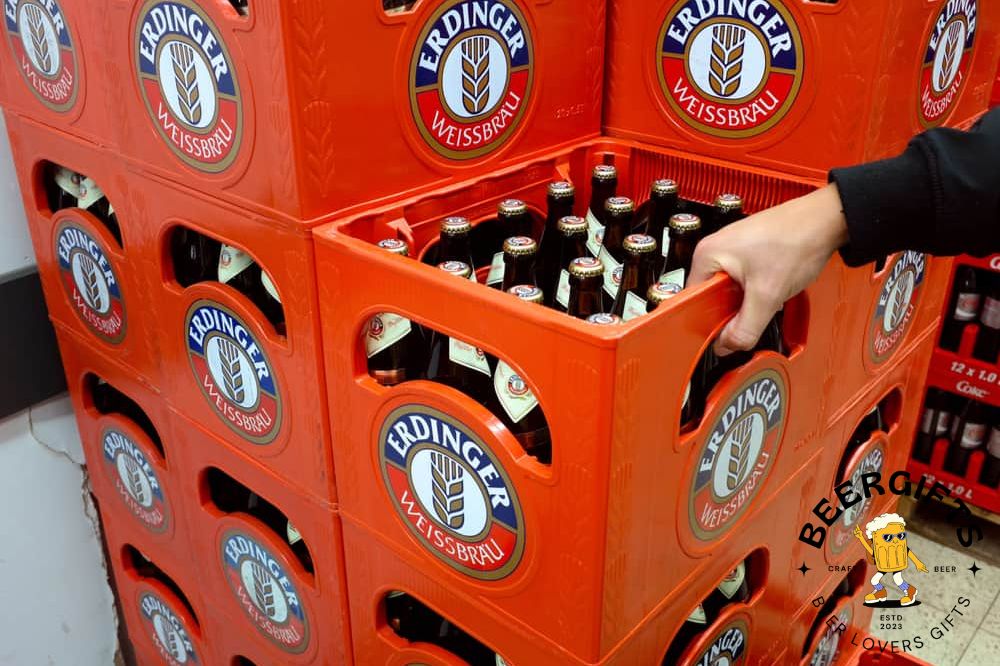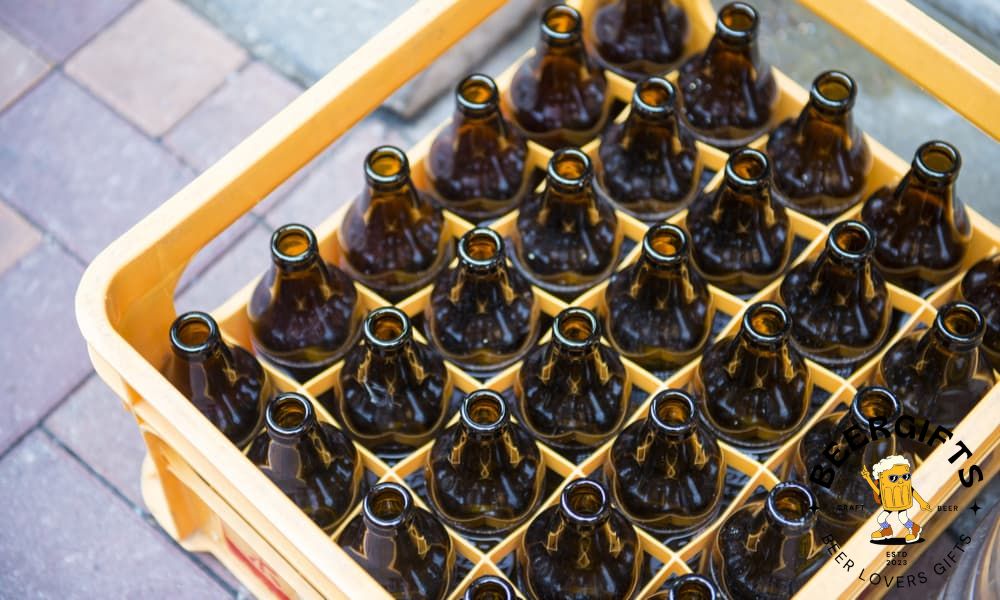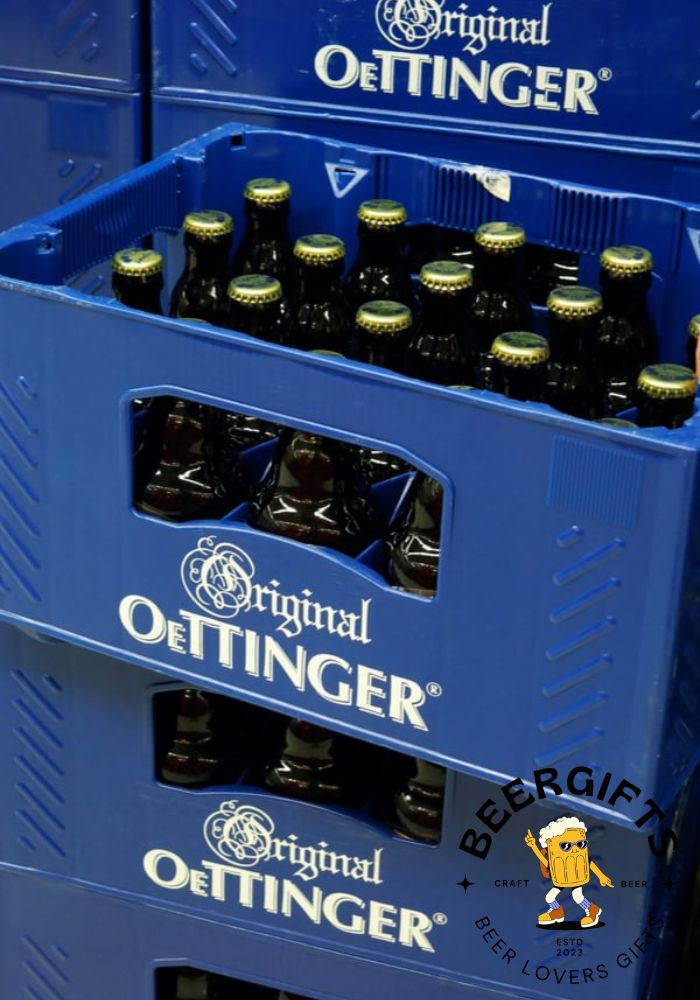You’ve probably heard of a beer crate or a six-pack – those seem pretty straightforward. But what’s all the confusion about beer racks? Today, we’re going to demystify this surprisingly simple element of zymology and beer talk.
So what is a rack of beer? And why do people always refer to a half-rack of beer but never a full one? Where does this terminology come from?
Beer Packaging Basics
Let’s begin by looking at the standard ways beer is packed around the world. You can buy beer in a bottle, a can, a keg, a box, or on tap. You can also buy it by the glass if you’re drinking at a bar. At parties, you’ll probably use a party cup, but the beer still comes from a keg, bottle, or can.
In the US, beers come in 12oz and 16oz packages. These can be bottles or cans. Stronger drinks sometimes come in 6oz. In Europe and other parts of the world, common sizes for beer bottles and cans include 300ml, 330ml, or 500ml. You can also find 550ml or 750ml packs on occasion.
When you talk about a case of beer or a crate of beer, you usually mean 24 cans in a carton, or maybe 24 bottles in a plastic case or crate. If you’re shopping at the liquor aisle or grocery store, beers are most commonly packed in sixes and held together with cardboard flaps or plastic tags.
Now we have to differentiate a beer rack from beer racking. That just means moving beer from one container to another during the brewing and packaging process. For example, pouring beer from cask to bottle, or from tap to glass. Quicker is better to avoid flattening the beer.
Do Colors Count?
Beer cans come in all shades from neon to matte. Their surfaces are often reflective, and because they’re metal, they chill (and heat up) quickly. For bottles, older beers were sold in brown bottles because it protects the drink from UV damage. Initially, beer bottles were clear, but sunlight soon ruined the beer so brewers opted for darker shades, and brown was a top selection.
Green bottles came into use during the war years. Lots of things were scarce then, including brown glass. Green glass was easier to find and became popular. But because we often associate brown with homely conservatives and green with growth and progress, a lot of us assume green-bottle beer has a higher quality and flavor than brown bottles, which are better overall.
Colors aren’t considered much in the beer rack discussion, but since racks and racking are factors in beer packaging, it’s worth touching on. And depending on where you live, a rack of beer means different things. To some, a rack is two dozen beers. They’ll talk about a six-pack of six, a half-rack of twelve, or a case or crate of twenty-four. They rarely mention full racks.
Rack Half Full?
But in other parts of the world, a rack is 30 bottles or cans of beer. It could be a matter of car sizes as well. If you’re buying beer in bulk (for home use) you’ll probably buy six-packs rather than cases or crates. So if these beers are arranged in sixes, then four six-packs make a rack. And those four sets of beer can comfortably fit across the roofing rack of a typical car.
This is highly anecdotal because most people put their beer in the trunk, or maybe the back seat. Not many drinkers would risk leaving their beer on the roof – especially if they’ve bought several cases. Practically speaking, the beer would probably get unpalatably warm and possibly degrade before your first sip. That’s if it doesn’t slip off the roof or get grabbed by college kids.
But whether it’s a wives’ tale or not, a lot of people assume 12 cans or bottles are half a rack and 24 cans or bottles are a full rack of beer. In this scenario, case, crate, and rack are assumed to mean the same thing. But sometimes, a brand may issue a special edition. Something like Bud Lights 30 Rack. In such cases, pun intended, the rack is used to mean 30 bottles or 30 cans.
Wine Crates and Beer Racks
Let’s make this even more complex. Yes, you can order a crate of wine and have it shipped for a special occasion. The wine crate is probably a wooden pallet stuffed with foam, straw, or other protective packaging. On the other hand, a wine rack is a decorative piece that displays your collection. They’re highly embellished, whether they’re on your kitchen island or your cellar.
Beer seems to be the opposite. A beer crate is hardy and plastic because it’s likely to be re-used and exchanged. You won’t turn it into a flower pot or DIY project when you’re done drinking. But a beer rack seems more like a descriptive packaging unit that will be tossed after use. A rack of beer is more likely to be a cardboard box or some cheap plastic film holding 24 to 30 cans.
Let’s throw another wrench in the works. In certain parts of Germany, a rack of beer is 16 returnable bottles. When you want a refill, you take the rack back and get six fresh bottles. Usually, part of the beer price is a ‘deposit’ for the bottle so if you break or lose the bottle, you forego the deposit. Teens (and kids) will often return bottles and claim the spare change.
Stacking and Packing
The physical dimensions of beer bottles (and cans) are designed for easy packing. Yes, stacks of beer bottles can easily cause a glass avalanche. But the nature of the beer business needs speed and bulk. So whether it’s in the warehouse, brewery, or shipping truck, your beer is likely to be boxed and stacked. In that sense, the term ‘beer rack’ could simply refer to piles of stored beer.
Another anecdote suggests ‘a rack of beer’ is a regulatory term. At one time, beer distributors in Washington only delivered beer in single stacks. This probably to avoid breakage. But these stacks came in packs of 24 and each pack had a single row. The bottles were never piled on top of each other. And these taller bottles would sit snug between a single fridge rack at home.
Along the same lines, kids and teens drink their beer differently. Often in cheap packs and large quantities. So illicit high schoolers will often talk about a rack of beer to mean a 30-pack of pocket-priced beer. Often Busch Light or something similarly low-end. It’s also a common slang term among surfers and beach drinkers – any place where you can 30 beers for less than $20.
Beer Racks for Artisanal Crafted Booze
Within home-brew racking space, you might hear the term ‘siphon’. This is when you draw your home-brewed beer from the keg or brewing chamber into bottles, cans, or serving containers. You can buy commercial gadgets to make this process more efficient. They reduce wastage and minimize beer exposure so it hits the can or bottle without ultraviolet damage or de-foaming.
One such device is the Rack Magic Beer Siphon. This isn’t so much a rack of beer – more like a rack for serving beer. It’s a dual-tube made of shatterproof plastic with food-grade bungs stoppers and valves. It dismantles so you can clean each part separately, keeping your homebrew hygienic and healthy. This racking cane is a little over two feet long (26.5 inches).
It works best with a siphon hose that’s between 3/8 inches and 5/16 inches. So yes, in certain places where English is a second or third language, it could happen. You might hear someone ask for a ‘rack of beer’ when what they want is a siphoning stick. And it can be quite entertaining (or frustrating, depending on your viewpoint) to figure out that loss in translation.
Ask Anonymous
This is one of those phrases that instantly tells your age. Did you think of agony aunts or faceless hackers? Well, in this case, we’ve settled on un-named internet commenters who sometimes dish out the best advice. And according to this one, a rack was once a six-pack, no further discussion.
In his/her words, ‘You could only buy a rack, a case, or a keg. A rack means 6, a case means 24, and a keg means frat boys.’ And just like all internet factoids, this seemingly definitive statement only opens more questions. For example, if the beer comes in a flat pack, is it still called a rack? Because some people refer to 18-packs as flats while others call a 24-flat-pack a rack…
Or maybe it’s more about cargo jargon. It could refer to whether the beer is stacked in rows, columns, racks, or crates. Are these beer cases arranged vertically or laid out on shelf grids? But even with all our research and references, it’s still unclear. So when someone asks you, “What is a rack of beer?” You can answer, “It’s either 16, 18, 24, or 30 cans or bottles. Buy a case instead.”





